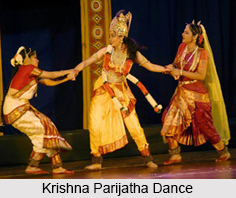 Krishna Parijatha is based on one of those mythological tales that is widely popular in Karnataka. This art form depicts the rich and vibrant culture of the land. The belief and customs of the people are reflected in these art forms. Krishna Parijatha is a folk theatre that is drawn from the ancient religious books. Revolving around Lord Krishna, it is a delight to watch drama being performed on stage. It is often presumed that Krishna Parijatha is an amalgamation of the themes of the other two popular dance dramas -Yakshagana and Byalatta. Krishna Parijatha is mostly popular in various districts of Northern Karnataka. From village squares to open markets, it continues to be a popular folk religious theatrical form.
Krishna Parijatha is based on one of those mythological tales that is widely popular in Karnataka. This art form depicts the rich and vibrant culture of the land. The belief and customs of the people are reflected in these art forms. Krishna Parijatha is a folk theatre that is drawn from the ancient religious books. Revolving around Lord Krishna, it is a delight to watch drama being performed on stage. It is often presumed that Krishna Parijatha is an amalgamation of the themes of the other two popular dance dramas -Yakshagana and Byalatta. Krishna Parijatha is mostly popular in various districts of Northern Karnataka. From village squares to open markets, it continues to be a popular folk religious theatrical form.
Mythological History behind Krishna Parijatha
Parijatha literally means the wish granting trees. There are various legends that are related to this anecdote. But the one, which is more popular, is the one that involves Lord Krishna. According to the legend, Parijatha tree emerged from the ocean of existence. It was planted in the garden of Lord Indra which was one of the gifts received from the samudra manthana, and thus was a celestial plant, not available on earth.
Myth about Krishna Parijatha
The story of Krishna Parijatha narrates how and why Lord Krishna, assisted by Narada tames the egoistic Satyabhama bringing home to her the point that the Lord always gave importance to Bhakti, like Rukmini did and Satyabhama did not. Narada brings a parijatha flower from Lord Indra`s garden and gifts it to Krishna. On Krishna`s advice he gives the flower to Rukmini, his favourite consort. Narada then goes to Satyabhama and narrates the whole story adding some salt and pepper that Rukmini is Krishna`s favourite.
Engraved with anger and jealousy, Satyabhama, the second wife of Lord Krishna, compels him to bring the tree from Indra`s garden. A war followed in which Indra was defeated. Indra cursed that the plant would never bear fruits, though it might bear flowers. Finally, the tree was planted on earth so that it proves to be beneficial for men. This entire story is enacted in Krishna Parijatha dance.
Performance of Krishna Parijatha
The story of Krishna Parijatha is performed in group. It beautifully portrays the rivalry and jealousy between the two consorts of Krishna - Rukmini and Satyabhama. The dancers usually wear glitterati attires and decorate themselves with beautiful jewelries resembling Lord Krishna, Rukmini, Satyabhama and other important characters. The wonderful performance of this drama takes the audiences to the mythical story of Krishna Parijatha.




















